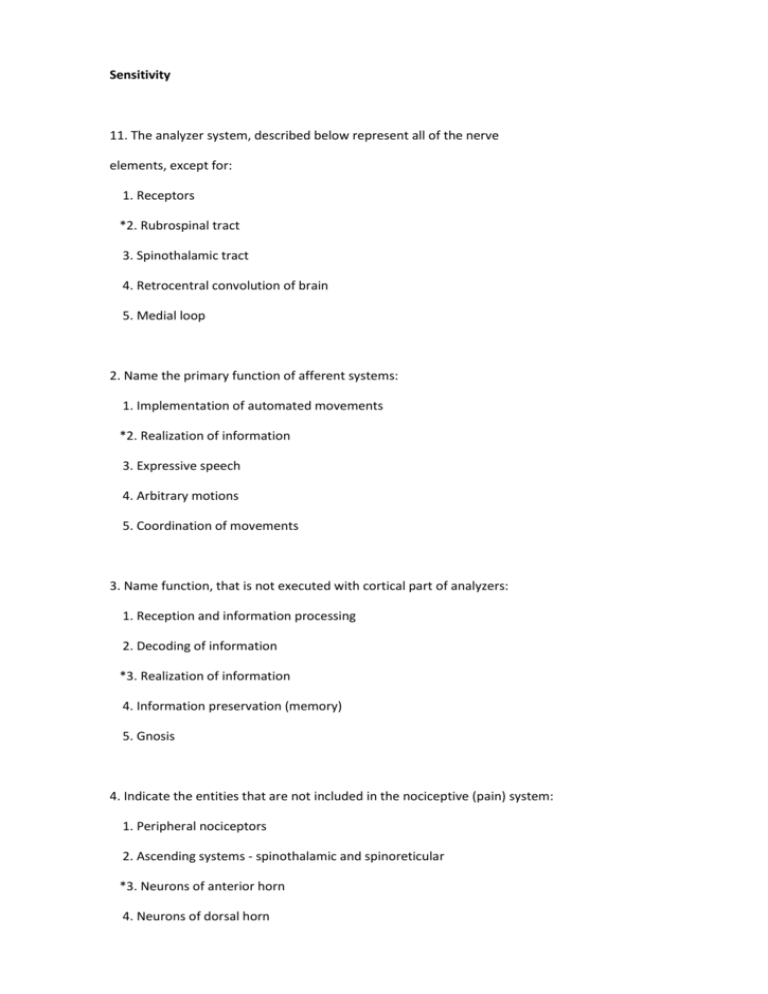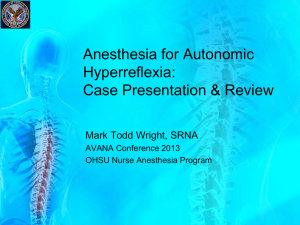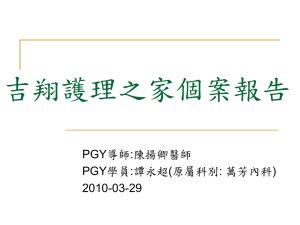5 Sensitivity
advertisement

Sensitivity 11. The analyzer system, described below represent all of the nerve elements, except for: 1. Receptors *2. Rubrospinal tract 3. Spinothalamic tract 4. Retrocentral convolution of brain 5. Medial loop 2. Name the primary function of afferent systems: 1. Implementation of automated movements *2. Realization of information 3. Expressive speech 4. Arbitrary motions 5. Coordination of movements 3. Name function, that is not executed with cortical part of analyzers: 1. Reception and information processing 2. Decoding of information *3. Realization of information 4. Information preservation (memory) 5. Gnosis 4. Indicate the entities that are not included in the nociceptive (pain) system: 1. Peripheral nociceptors 2. Ascending systems - spinothalamic and spinoreticular *3. Neurons of anterior horn 4. Neurons of dorsal horn 5. Nociceptive systems of cerebrum 5. Indicate ascending pathway, that will transmit nociceptive (pain) information: 1. Ways of Goll and Burdach 2. Vestibulospinal *3. Spinothalamic 4. Rubrospinal 5. Swalbe 6. Which of the following types of sensitivity are considered complex: *1. Sense of localization 2. Pain 3. Temperature 4. Deep muscular-articulate and vibration 5. Tactile 7. What kind of sensitivity is considered simple: *1. Painful 2. Stereognostic 3. Two-dimensional-spatial feeling 4. Discrimination 5. Sense of localization 8. Which of the following do not apply to specific sensitivity: 1. Sight 2. Taste *3. Memory 4. Scent 5. Hearing 9. Indicate, where is the first body of neurons of all types of sensitivity located: 1. posterior horn of spinal cord 2. Lateral horn of spinal cord *3. Intervertebral junction 4. Nucleus of Goll and Burdach 5. Thalamus 10. Indicate, where first neurons of pain and temperature sensitivity end: 1. Nucleus of Goll and Burdach 2. Thalamus 3. Posterior central convolution *4. Posterior horn of spinal cord 5. Lateral horn of spinal cord 11. Indicate, where does the first neuron of deep sensation end: 1. Posterior horn of spinal cord 2. Lateral horn of spinal cord *3. Nucleus of Goll and Burdach 4. Thalamus 5. Posterior central convolution 12. Indicate, where do the second neurons of all kinds of sensitivity end: 1. Posterior horn of spinal cord 2. Lateral horn of spinal cord 3. Nucleus of Goll and Burdach *4. Thalamus 5. Convolution of the brain 13. Indicate, where do the second neurons of superficial kinds of sensitivity overlap: 1. On level of Posterior spinal horns *2. Equal to the front of white frequency 3. On level of Oblongata 4. On level of pons varolii 5. On level of red nuclei 14. Indicate, where do second neurons of deep kinds of sensitivity overlap: 1. At the front of white frequency 2. On border of spinal and medulla oblongata 3. On level of pons varolii 4. On level of thalamus *5. In interolive layer on level of Oblongata 15. Indicate, what path forms part of medial loop: 1. Corticospinal *2. Spinothalamic 3. Column of Gowers 4. Thalamocortical 5. Bunches of Goll and Burdach 16. Indicate, where is the cortical part of general kinds of sensitivity located: *1. In postcentral convolution of the brain of parietal lobe 2. In precentral convolution of the brain 3. In frontal lobe 4. In temporal lobe 5. In occipital lobe 17. Indicate, Sensitive innervation of hand is presentedin which part (zone) of cortex projection: 1. In bottom postcentral convolutions of the brain 2. In top of postcentral convolutions of the brain 3. In top of precentral convolution of the brain 4. In middle part precentral convolution of the brain *5. In middle part retrocentral convolution of the brain 18. Indicate, sensitive innervation of head is presented in what part of cortex projection: *1. In bottom postcentral convolutions of the brain 2. In top postcentral convolutions of the brain 3. In top precentral convolution of the brain 4. In middle part retroctntral convolution of the brain 5. In bottom precentral convolution of the brain 19. Indicate, sensitive innervation of lega are presented in what part of cortex projection : 1. In lower postcentral convolutions of the brain *2. In top postcentral convolutions of the brain 3. In top precentral convolution of the brain 4. In middle part retroctntral convolution of the brain 5. In bottom precentral convolution of the brain 20. Name quantitative types of disturbances of sensation: *1. Hypesthesia 2. Hyperpathia 3. Polyesthesia 4. Causalgia 5. Dysesthesia 21. All of the following are qualitative kinds of disturbances of sensation except: 1. Bathyanesthesia 2. Dysesthesia 3. Polyesthesia *4. Hyperesthesia 5. Hyperpathia 22. By types of disturbances of sensation all of the below mentioned will be present except: 1. It conduction *2. Hypoesthesia 3. Mononeuritic 4. Polyneuritic 5. Segmentary 23. Indicate, absence of what kinds of sensitivity is observed at full destruction of peripheral nerve: *1. All kinds of sensitivity 2. Only painful and temperature 3. Muscular-only articulate 4. Only vibrating 5. Only tactile 24. What grounds will not apply to attributes of lesion of intervertebral unit: *1. Anesthesia behind polyneuritic type 2. Segmental anesthesia 3. Pain 4. Anesthesia of all kinds of sensitivity 5. Herpes eruption 25. Name the feature which is not characteristic to the lesion of posterior root: 1. Extending to and projectional pains 2. Segmental anesthesia *3. Anesthesia behind polyneuritic type 4. Symptoms of tension on the affected side 5. Anesthesia of all kinds of sensitivity 26. Name attributes of a lesion of Posterior spinal horn: 1. Anesthesia of all kinds of sensitivity behind benzodiazepine receptor *2. Segmentary anesthesia of pain and temperature sensitivity 3. Segmentary anesthesia of deep kinds of sensitivity 4. Segmentary anesthesia of all kinds of sensitivity 5. Symptoms of tension 27. Name attributes, that are not characteristic for a lesion on the posterior cord of spinal cord: 1. Conduction anesthesia of deep kinds of sensitivity 2. Sensitive ataxium *3. Shooting pain 4. Preservation of superficial kinds of sensitivity 5. Bathyanesthesia 28. Name symptoms of lesions of lateral cord of spinal cord: 1. Bathyanesthesia 2. Shooting pain on the affected side 3. Segmentary anesthesia of all kinds of sensitivity 4. Anesthesia of all kinds of sensitivity on polyneuritic type *5. Conductive anesthesia of superficial kinds of sensitivity on Opposite sides 29. Indicate attributes of a lesionon on the medial loop in brain trunk: 1. Hemiplegium 2. Hemianopsium *3. Unilateral anesthesia on opposite side 4. Unilateral anesthesia on the affected side 5. Hemiataxium on the affected side 30. What complication will not concern to symptoms of lesion of thalamus: 1. Unilateral anesthesia from opposite side 2. Hemianopsium from opposite side *3. Unilateral anesthesia on the affected side 4. Pain on opposite side 5. Hemiataxium from opposite side 31. Indicate symptoms of typical lesion in the cortex in retrocentral convolution of the brain: 1. Unilateral anesthesia from opposite side 2. Unilateral anesthesia on the affected side *3. Monoanesthesia from opposite side 4. Monoanesthesia on the affected side 5. Hemiplegium of opposite extremities 32. All kinds of sensitivity decrease at lesion of what nerve formations: 1. Forward white soldering *2. Peripheral nerves 3. Back cords 4. Posterior spinal horn 5. Spinothalamic ways 33. Indicate, a lesion at the location of which structure would disturb sensitivity of a segmented type. 1. Back cords *2. Posterior spinal horn 3. Lateral cords 4. Medial loop 5. Peripheral nerves 34. Indicate the symptoms, characteristic for polyneuritic type sensitive disturbances: 1. Unilateral anesthesia *2. Anesthesia in distal parts of extremities 3. Monoanesthesia 4. Anesthesia behind type "jacket" 5. Dissociation of sensitive dissonances 35. At lesion of what nervous structures sensitivity is broken on conduction type: 1. Posterior spinal horn *2. Back cord of spinal cord 3. Forward white soldering 4. Nuclei of nervus trigeminalis 5. Spinal ganglion 36. There where is cortical representation of analyzers: 1. Extrapyramidal system 2. Prefrontal brain site 3. Thalamus *4. Occipital lobes 5. Nonspecialize systems of brain 37. Indicate symptom of lesion of peripheral nerve: 1. Unilateral anesthesia 2. Anesthesia behind polyneuritic type *3. Anesthesia of all kinds of sensitivity in zone of innervation 4. Segmental anesthesia 5. Dissociation of disturbances of sensation 38. Unilateral anesthesia, hemiataxium, hemianopsium arise due to lesions at what part of nervous system: 1. Optic chiasmum 2. Medial loop *3. Thalamus 4. Bark of occipital lobe 5. Back central convolution of the brain 39. Astereognosis arises due to a lesion at which part of nervous system: 1. Dorsal roots 2. Posterior corn ofspinal cord 3. Lateral cords of spinal cord 4. Frontal share of cerebrum *5. Parietal share of cerebrum 40. A lesion of what structures causes unilateral anesthesia which is united with hemianopsium: 1. Bark of occipital lobe 2. Bark of parietal lobe *3. Internal capsule 4. Medial loop 5. Optic chiasmum 41. A lesion at what nervous formation causes infringement of segmentary type sensitivity on the face of a person: 1. Internal capsule 2. Inferior retroctntral convolution of the brain *3. Nucleus of spinal path of trifacial 4. Gasser ganglion 5. Twigs of trifacial 42. Disorder of sensitivity by the type "glove" and "socks" when patient complains of tingling sensation, are usually developed in hands and legs at diseases of : *1. Peripheral nerves 2. Back rootlets of spinal cord 3. Brachial plexus 4. Spinal cord 5. Visual hump 43. At patient revealed distortion of pain and temperature sensitivity from the left in Th2-Th5 segments. It is possible to assume lesion of what nervous formations: 1. Peripheral nerves *2. Posterior horn of spinal cord 3. Posterior cords of spinal cord 4. Lateral cords of spinal cord 5. Dorsal roots 44. The patient revealed a distortion of pain and temperature sensitivity while preserving the tactile level C5. What type of violations of the sensitivity are present in the patient: 1. Mononeuretic 2. Polyneuritic 3. Radicular *4. Segmentary dissociated 5. Conduction spinal 45. A patient after diphtheria developed a sensation of "crawling of ants" in hands, feet, distortion of all kinds of sensitivity in distal parts of hands and legs. What nervous structures are damaged in patient: *1. Peripheral nerves 2. Dorsal roots 3. Posterior horn of spinal cord 4. Lateral cords of spinal cord 5. Visual hump 46. A patient presents with left-sided unilateral anesthesia of all kinds of sensitivity and "spontaneous" pain on the same side. Indicate place of localization of focus: 1. Posterior horn of spinal cord at the left 2. Lateral cords of spinal cord at the left 3. Medial loop on the right *4. Thalamus on the right 5. Internal capsule on the right 47. A patient presents with sensation of numbness of right side of body and left side of face after influenza. In these sites distortion of pain and temperature sensitivity are revealed. Indicate syndrome of distortion of sensitivity in patient: 1. Segmentary dissociated 2. Radicular *3. Alternating hemianesthesia 4. Syndrome of Brown-Sechar 5. Polyneuritic 48. A patient has right-sided central paralysis of leg united with distortion of exteroceptive sensation on right side of the body bellow the bellybutton and distortion of muscular-articulate feeling in left leg. Patient developed what syndrome: 1. Syndrome of Argile-Robertson 2. Alternating syndrome of Jackson 3. Parcinson *4. Syndrome of Brown-Sechar 5. Syndrome of Bernard-horner unit 49. In woman, 42 yrs old. Pathological process distrubed posterior horns of cervical intumescence (syringomyelion). What type of infringement of sensitivity does patient have: 1. Peripheral mononeuretic 2. Conduction spinal 3. Conduction cerebral *4. Segmentary 5. Peripheral polyneuritic 50. 5yr old boy sick with diphtheria, developed pain and numbness in hands and legs. Disturbance of all kinds of sensitivity in distal parts of limbs. What type of infringement of sensitivity does the patient present with: 1. Mononeuretic *2. Polyneuritic 3. Conduction spinal 4. Conduction cerebral 5. Segmentary 51. In 39 yr old woman- right-sided hemi-anesthesia of all kinds of sensitivity and spontaneous thermalgia in right side of body. Pathological center are located where: *1. Thalamus at the left 2. Thalamus body 3. Brainstem 4. Frontal particle on the right 5. Frontal particle at the left 52. 19 yr old woman complains about the appearance of "crawling of ants" on the left hand, and left side of her face. These disturbances are known as: 1. Paresis 2. Anesthesia 3. Hypesthesia *4. Paresthesia 5. Hyperesthesia 53. Man 50 years old complains of back pain, and posterior surface of right hip. What symptom is it necessary to check for to specify the level and character of lesion: *1. Lasegue 2. Kernig 3. Brudzinsky 4. Marinescu-Radovici 5. Bella 54. In woman, 39 yrs old. At examination dissociate segmentary type of disturbance of sensitivity on left hand is revealed. What symptom does patient have: 1. Anesthesia of all kinds of sensitivity in the zone ‘4 -‘7 left sided 2. Anesthesia of deep kinds of sensitivity in the zone ‘4 -‘7 left sided *3. Anesthesia of superficial kinds of sensitivity in the zone ‘4 -‘7 left sided 4.Paresthesia in left hand 5. Fibrillation in left hand 55. A patient has hemi-hypoesthesia of the body, hyperpathia on the same side, pain in right extremities and trunk. What is disturbed in patient: 1. Internal capsule at the left 2. Medial loop at the left 3. Oblongata at the left 4. Beam wreath at the left *5. Thalamus at the left 56. In a patient, loss of superficial types of sensitivity behind segmentary type in zone Th5-Th8 segments from both sides is determined Where can the lesion be localized: 1. Lateral cords of spinal cord on level Th6-Mh8 segments 2. Anterooms of horn of spinal cord on level Th5-Th6 segments 3. Medial loop *4. Forward white soldering on level Th5-Th8 segments 5. Back cords of spinal cord on level Th5-Th8 57. Patient losses of all kinds of sensitivity (superficial and deep) behind hemitype from the left, hemiparesis and hemianopsium also from the left. What is disturbed in the patient: 1. Brainstem body 2. Medial loop at the left *3. Internal capsule on the right 4. Anterior central convolution on the right 5. Visual hump on the right 58. A patient has loss of deep types of sensitivity from level Th6 on the right. Where is the lesion located: 1. Anterooms of horn at level of Th6 body 2. Forward white soldering on level Th6 *3. Back cords on the level of Th6 4. Back horn on level Th6 on the left 5. Lateral shafts on level Th4 on the left 59. Patient has decreased sensitivity on the right side of face, left extremities, and left side of body (alternating type of sensitivity disturbance). Where the the lesion located: 1. Right postcentral convolutions of the brain 2. Inside capsule on the right *3. Brainstem body 4. Spinal cord on the level ‘1 -Mh4 body 5. Visual hump body 60. Patient has an unstable walk. Falls in the Romberg position, misses when performing Finger-nose and calcaneal-knee tests with closed eyes. Pail and temperature sensitivity are present. Bad recognition of finger position. What is affected in the patient: 1. All parts of cerebellum 2. Vermis *3. Back cords of spinal cord 4. Cerebellar hemisphere 5. Nuclei vestibularis 61. At patient has right-sided hemi-hypoesthesia, discturbance of body scheme, astereognosis, apraxium, acalculion, epileptic seizures, that begin from paresthesia in the right hand. Pathological focus can be located where: *1. In parietal part of left hemisphere 2. In postcentral convolution of the brain on the left 3. In precentral convolution of the brain on the left 4. In frontal lobe on the left side 5. In occipital lobe at the left 62. Patient received knife injury in cervicalarea. Loss of articulate-muscular, tactile, vibrating feeling from‘5 is determined.And temperature sensitivity from level of ‘7, on the left. What is disturbed in patient: 1. Weigh spinal cord on the level ‘5 *2. Half spinal cord on the level ‘5 3. Half spinal cord on the level ‘7 4. Half spinal cord on the level ‘5 At the left 5. Dorsal roots ‘5 -‘7 At the left 63. A patient has dislocation of right shoulder joint after falling from a height. Pain continued after repositioning, and also loss of all kinds of sensitivity on right hand was revealed. What is affected in patient: 1. posterior horn on the right 2. Lateral trunk on the left 3. Posterior trunk on the right 4. Ulnar nerve on the right *5. Brachial plexus on the right 64. Patient complained of less of feeling on the left side of her body, face, and extremities.. At review hemi-hypoesthesia at midline is determined. What type of sensitivity is mentioned with the: 1. Hemitype 2. Polyneuritic *3.functional 4. It segmentary 5. Conduction it spinal 65. In patient conduction type of infringement of deep kinds of sensitivity of body from level Th10 checks out on the right, conduction type of infringement of superficial kinds of sensitivity at the left from level of Th12, segmentary type of infringement of all kinds of sensitivity of body on level Th10. What is striked at patient: 1. Medial loop on the right 2. Spinal cord on level Th10 (full shunt fault) 3. Back cords of spinal cord from two parties *4. Half segment of spinal cord Th10 5. Lateral cords of spinal cord from two parties








